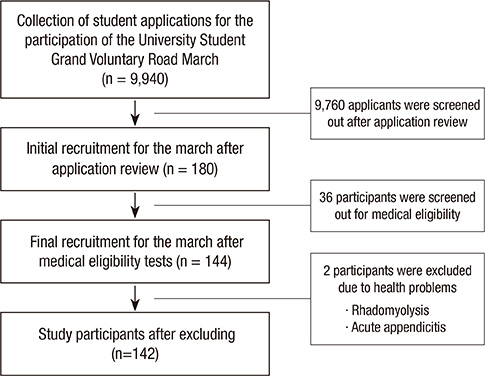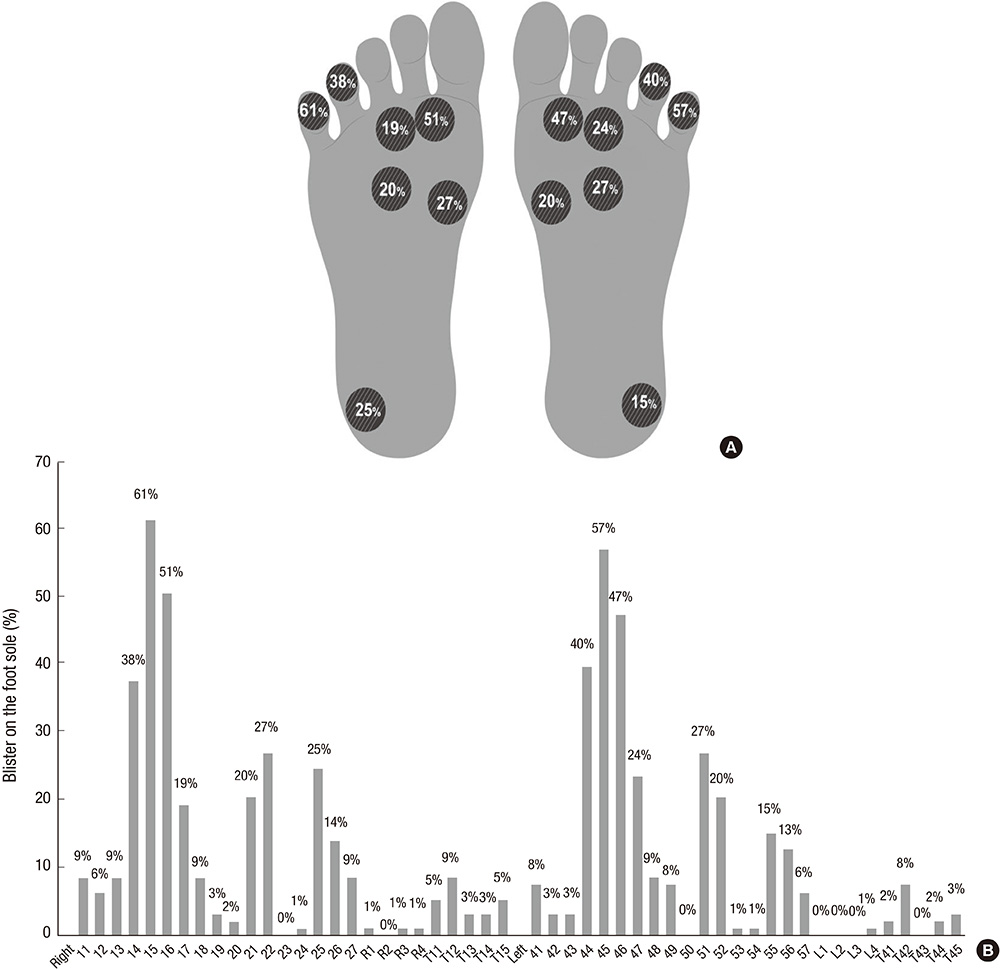J Korean Med Sci.
2013 Dec;28(12):1814-1821. 10.3346/jkms.2013.28.12.1814.
Injuries Associated with the 580 km University Student Grand Voluntary Road March: Focus on Foot Injuries
- Affiliations
-
- 1Department of Emergency Medicine, Ajou University School of Medicine and Ajou University Hospital, Suwon, Korea. flyingguy0202@hanmail.net
- KMID: 1779425
- DOI: http://doi.org/10.3346/jkms.2013.28.12.1814
Abstract
- College student volunteers (n = 142) completed a 580 km road march for 21 consecutive days. Each volunteer carried a backpack that weighed 14.1 +/- 1.4 kg on the average. We investigated the incidence and location of blisters associated with the road march using a foot map along with other injuries. Overall, 95.1% of the subjects (135 of 142) sustained one or more injuries. All injured subjects had foot blisters, and 18% had other foot injuries. The most common locations of blister development were the right 5th toe (61%) and the left 5th toe (57%). The little toes seem to have been subjected to the greatest friction and shearing forces. March-related injuries, excluding foot injuries, were ankle pain (12.7%), knee pain (12.7%) and Achilles tendon pain (7.7%). Six subjects (4.2%) needed extra medical treatment for more than 2 weeks prior to returning to their daily lives after completion of the march due to associated injuries. The present study observed a very high incidence rate of injuries (95.1%) associated with the 580 km university students grand road march. These injuries posed an obstacle against completion of the road march and against returning to daily life. Active preventive interventions such as physical therapy and customized reinforced shoes and education program are recommended for reducing incidence rate and severity of injuries.
Keyword
MeSH Terms
Figure
Reference
-
1. Knapik J, Reynolds K, Staab J, Vogel JA, Jones B. Injuries associated with strenuous road marching. Mil Med. 1992; 157:64–67.2. Reynolds KL, White JS, Knapik JJ, Witt CE, Amoroso PJ. Injuries and risk factors in a 100-mile (161-km) infantry road march. Prev Med. 1999; 28:167–173.3. Renbourn ET. The knapsack and pack; an historical and physiological survey with particular reference to the British soldier. J R Army Med Corps. 1954; 100:77–88.4. Tomlinson JP, Lednar WM, Jackson JD. Risk of injury in soldiers. Mil Med. 1987; 152:60–64.5. Temple-Wright R. The Soldier's Boot. Br Med J. 1896; 1:116–117.6. Legg SJ. Comparison of different methods of load carriage. Ergonomics. 1985; 28:197–221.7. Allan JR, Macmillan AL. The immediate effects of heat on unacclimatized paratroops: exercise "Tiger Brew II": UK: Army Operational Research Establishment. United Kingdom Research Memorandum;1963.8. Hoeffler DF. Friction blisters and cellulitis in a navy recruit population. Mil Med. 1975; 140:333–337.9. Dalén Å, Nilsson J, Thorstensson A. Factors influencing a prolonged foot march. Stockholm: FOI Totalförsvarets forskningsinstitut;1978.10. Johnson RF, Knapik JJ, Merullo DJ. Symptoms during load carrying: effects of mass and load distribution during a 20-km road march. Percept Mot Skills. 1995; 81:331–338.11. Knapik JJ, Reynolds KL, Duplantis KL, Jones BH. Friction blisters: pathophysiology, prevention and treatment. Sports Med. 1995; 20:136–147.12. Knapik JJ, Reynolds K, Barson J. The influence of antiperspirants on foot-blister incidence following road marching. West Point: DTIC;1997.13. Jones BH. Overuse injuries of the lower extremities associated with marching, jogging, and running: a review. Mil Med. 1983; 148:783–787.14. Harmon SE. Medical problems of marching musicians. Med Probl Perform Art. 1993; 8:132–135.15. Mehler AS, Brink DS, Eickmeier KM, Hesse DF, McGuire JW. Marching band injuries: a one-season survey of the University of Michigan Marching Band. J Am Podiatr Med Assoc. 1996; 86:407–413.16. Knapik J, Staab J, Bahrke M, Reynolds K, Vogel J, O'Connor J. Soldier performance and mood states following a strenuous road march. Mil Med. 1991; 156:197–200.17. Friedl KE, Nuovo JA, Patience TH, Dettori JR. Factors associated with stress fracture in young army women: indications for further research. Mil Med. 1992; 157:334–338.18. Kimsey CD. The epidemiology of lower extremity injuries in United States Marine Corps recruits. Columbia: University of South Carolina;1993.19. Jones BH, Cowan DN, Tomlinson JP, Robinson JR, Polly DW, Frykman PN. Epidemiology of injuries associated with physical training among young men in the army. Med Sci Sports Exerc. 1993; 25:197–203.20. Hanlon W. Soldier performance and strenuous road marching: influence of load mass and load distribution. Mil Med. 1997; 162:62–67.21. Kaufman KR, Brodine SK, Shaffer RA, Johnson CW, Cullison TR. The effect of foot structure and range of motion on musculoskeletal overuse injuries. Am J Sports Med. 1999; 27:585–593.22. Knapik JJ, Reynolds K, Barson J. Risk factors for foot blisters during road marching: tobacco use, ethnicity, foot type, previous illness, and other factors. Mil Med. 1999; 164:92–97.23. Naylor PF. Experimental friction blisters. Br J Dermatol. 1955; 67:327–342.24. Comaish JS. Epidermal fatigue as a cause of friction blisters. Lancet. 1973; 1:81–83.25. Coopers DS. Research into foot lesions among Canadian Field Forces: 13th Commonwealth Defence Conference on Operational Clothing and Combat Equipment. In : Commonwealth Defence Conference; Malaysia, Ottawa, Ontario, Canada. 1981. Report CDA-11.26. Herring KM, Richie DH Jr. Friction blisters and sock fiber composition: a double-blind study. J Am Podiatr Med Assoc. 1990; 80:63–71.







